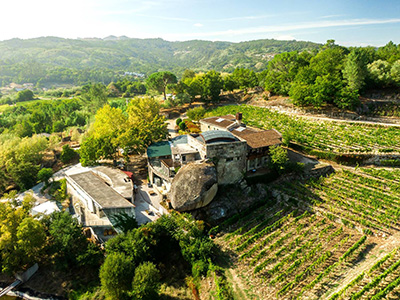
The Meín vineyard, in the village of Leiro (Ourense), appears in Galician history books as one of the first inhabited settlements around the San Clodio Monastery. As early as 1158, its abbot mentioned the outstanding quality of the grapes grown there.
As it stands today, Viña Meín contributed considerably to set the style of modern Ribeiro. The project dates from 1988, when indigenous grape varieties, notably Treixadura, were planted and recovered. Behind it were a group of friends and relatives led by Javier Alén, a lawyer and businessman deeply attached to the area -he used to spend his childhood summers with his grandparents in Leiro. In July 2019, Ribera del Duero producer Pago de Carraovejas purchased both Viña Meín and Emilio Rojo.
From Ribera del Duero to Ribeiro
Located in Peñafiel, Pago de Carraovejas was the seed to build an impressive group of wineries now called Alma Carraovejas. It includes Ossian Vines and Wines (old vine Verdejo from Segovia), Milsetentayseis (a second venture in Ribera based in the village of Fuentenebro) and Aiurri in Rioja. Owned by the Ruiz Aragoneses family, they also run the renowned José María restaurant in Segovia.
In Ribeiro they took control of two of the leading producers in the area. Viña Meín was the first white ribeiro to make a name for itself in the competitive wine scene in Madrid, whereas Emilio Rojo conjures up the image of a devoted vigneron who makes just a single ageworthy premium wine in limited quantities. As part of the deal, Rojo continues to be involved in the winemaking. The brand, which has already achieved cult status, retails around €120 in Spain.
Vineyards include the small, 1.2 hectare plot behind Emilio’s wine, plus 18 hectares of Viña Meín. The current owners have increased the number to 24. All of them are located in the Avia valley.
Rojo’s vineyard, which was formerly part of the monastery of San Clodio, is on the right bank, in Ibedo, an ancient rural settlement close to the town of Leiro which was abandoned 40 years ago, and faces east. Vines are grown in terraces built with stone walls locally called socalcos. They are planted midway up the slope, as it was done in traditional sites, fully protected from frosts as the cool air drops to the bottom of the valley. Soils, locally known as sábrego, are shallow granite, with sandy texture and varying quantities of gravel.
Viña Meín's vineyards stretch all along the left bank of the valley where the sábrego soils are also dominant. Most of the plots are in San Clodio, grown at an altitude ranging from 100 to almost 200 meters. The largest is the 2.5-hectare Meín estate, where the winery is located. The oldest plot was planted with Alicante Bouschet, in 1960. A Vilerma and Tega do Sal are in the neighbouring parish of Gomariz, their soils including various elements other than granitic sands: clay for Vilerma and pebbles and schist in the case of Tega do Sal, from which a single-vineyard white was formerly made. These grapes are now part of the Viña Meín cuvées. There are two other plots planted with red grapes in the hamlets of Ribeira (Brancellao) and Osebe (Caíño Longo).
Building a new range of wines
The work of Alma Carraovejas with Laura Montero as consultant begins with the 2018 vintage blend. A red dot was added to the label to distinguish it from a previous bottling of the same vintage. The aim was to gain complexity by blending grape varieties and plots. In the 2019 vintage the Bordeaux-inspired model of a first and second wine was introduced. The first wine, called O Gran Meín, was assigned to all the batches with greater ageing potential, while the more straightforward, immediate wines were destined for O Pequeño Meín ('pequeño' means little).
As the‘little wine’ was gaining consistency, the owners decided to drop the diminutive from the name in the 2022 vintage and simply call it Meín Castes Brancas (35,000 bottles, 17 €). From 2023, O Gran Meín will be sourced exclusively from the property's original 2.6 hectares, planted in amphitheatre-shaped terraces and will be released five years after the harvest.
Treixadura accounts now for roughly 55-60% of the blend. This adds extra tension thanks to the higher acidity of varieties like Loureiro or Albariño, while retaining Godello, Torrontés and Lado, all of them part of the region's grape heritage. Winemaking takes place in various vessels: stainless steel tanks, foudres, 600-litre barrels and concrete to a lesser extent.
The red range started with O Gran Meín (€42) in the 2019 vintage; in 2020 O Pequeño Meín was added, following the same pattern as the whites. But from the 2021 vintage, the ‘little one’ will be called simply Meín. The wine shows the mosaic of red grape varieties grown in Ribeiro. It is made from Caíño Longo, Garnacha Tintorera, Brancellao, Sousón, Ferrón and Caíño Tinto grown on small plots in the villages of Leiro and Pazos de Arentiero. All the batches are fermented separately and then aged in stainless steel tanks.
Most popular
NEWSLETTER
Join our community of Spanish wine lovers


